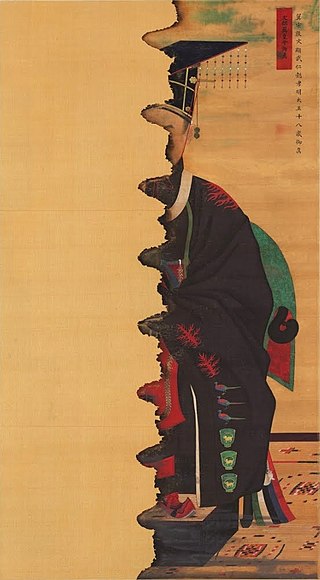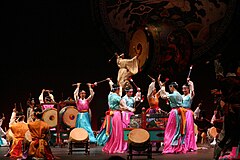
In Korea, that refers to music from the Korean peninsula, ranging from prehistoric times to the division of Korea into South and North in 1945. It includes court music, folk music, poetic songs, and religious music used in shamanistic and Buddhist traditions. Together, traditional Korean music is referred to as gugak, which literally means "national music."

The traditional culture of Korea is the shared cultural and historical heritage of Korea before the division of Korea in 1945.

Korean court music comprises three main musical genres: aak, an imported form of Chinese ritual music; a pure Korean form called hyangak; and a combination of Chinese and Korean styles called dangak.
Hyangak, literally "indigenous/native music, folks music" is a traditional form of Korean court music with origins in the Three Kingdoms period. It is often accompanied by traditional folk dances of Korea, known as hyangak jeongjae. These dances are performed in front of audiences—as opposed to the square dance more familiar to Westerners, which is primarily for the participants' enjoyment.

Buchaechum (부채춤), also called Buchaechum fan dance or just fan dance, is a Korean fan dance originating from various traditional and religious Korean dances. It is usually performed by groups of female dancers.

The taepyeongso is a Korean double reed wind instrument in the shawm or oboe family, probably descended from the Persian sorna and closely related to the Chinese suona. It has a conical wooden body made from yuja (citron), daechu (jujube), or yellow mulberry wood, with a metal mouthpiece and cup-shaped metal bell. It originated during the Goryeo period (918–1392).
Tōgaku is the Japanese pronunciation of an early style of music and dance from the Tang Dynasty in China. Tōgaku was introduced into Japanese culture from China no earlier than the 8th century, and is still performed as one style of the imperial court music called gagaku.
During the Nara period (710–794), music and dances continued to flow into the capital from many parts of Asia. Many styles were eventually organized under two basic categories of gagaku. The first, tōgaku, consisted of pieces of Chinese and Indian origin, while komagaku included Manchurian, Korean, and many of the Japanese pieces. These two styles can be distinguished by their instrumentations.

The buk (Korean: 북) is a traditional Korean drum. While the term buk is a native Korean word used as a generic term meaning "drum", it is most often used to refer to a shallow barrel-shaped drum, with a round wooden body that is covered on both ends with animal skin. Buk are categorized as hyeokbu which are instruments made with leather, and has been used for jeongak and folk music.
Dangak is a genre of traditional Korean court music. The name means "Tang music", and the style was first adapted from Tang Dynasty Chinese music during the Unified Silla period in the late first millennium. It was continued through the Goryeo (918–1392) and Joseon (1392–1910) dynasties, when, along with hyangak and aak it was one of the three approved genres of court music. Dangak performances were accompanied by Tang-style dances known as dangak jeongjae.
Sujecheon is a Korean court music composition in four movements dating to the mid-7th century Baekje era. It is the most representative piece in the jeongak repertoire. It is performed by an ensemble composed primarily of wind instruments, including the piri and daegeum. It originally had a vocal part, but today is performed instrumentally. The title Sujecheon may be translated as "Long Life, Immeasurable as the Heavens."

Geommu is a traditional sword dance practiced in Korea. Geommu is performed with special costume, dance moves, and music. The dance is known for its grace in performance. Extra emphasis is placed on the movement of the costuming, notably the sleeves, in harmony with the movements of the dancer. The symbolic use of ssang dan geom, i.e. a replica of dual short swords, keeps to the militaristic origins of this dance. Geom-mu has become a dance of great beauty and is treasured as the South Korea's 12th Important Intangible Cultural Property.

The bipa is a pear-shaped lute that is a traditional Korean musical instrument. It is derived from Chinese pipa and was introduced through the Silk Road to Goguryeo and Silla. There are two major types of bipa: the four stringed dang-bipa and the five stringed hyang-bipa. While dang-bipa was a Tang-style pipa first introduced from the Chinese Tang dynasty and localized over time to have Korean characteristics, hyang-bipa was created in the Korean Kingdom of Silla. The instrument is also related to other derivatives such as Vietnamese đàn tỳ bà and the Japanese biwa.
Seungjeonmu is a Korean court dance to wish for and celebrate victory. It is originated 2000 years ago and is composed of a sword dance and drum dance called mugo. Seungjeonmu or Dance of Military Triumph was performed to wish for victory from gods of earth and heaven when the nation was at war. Seungjeonmu is South Korea's Important Intangible Cultural Properties number 21, designated on December 21, 1968. The dance is performed in honor of Admiral Yi Sun shin who gained victory during the Imjin war (1592-1598) of the mid-Joseon dynasty.

Mugo is a jeongjae, Korean court dance performed with drum. It was created in the Goryeo dynasty era. It also practiced in ritual dance of Seungjeonmu. Its name comprises the two words, mu and go literally meaning dance and drum in Korean respectively.

Seungmu is a Korean dance performed by Buddhist monks. It is one of the most famous Korean traditional dances and designated as South Korea's important intangible cultural asset number 27 in 1969. It has been developed into a solo dance by professional dancers.

Jongmyo Jerye (Korean: 종묘제례) or Jongmyo Daeje (종묘대제) is a traditional rite held for worshipping the deceased Joseon monarchs in Jongmyo Shrine, Seoul, South Korea. It is held every year on the first Sunday of May. The Jongmyo rite is usually accompanied with the court music playing (Jerye-ak) and dance called Ilmu or line Dance. Jongmyo Jerye and Jeryeak were designated as the first of South Korea's Masterpieces of the Oral and Intangible Heritage of Humanity by UNESCO in 2001.

Cheoyongmu is a representative Korean mask dance based on the legend of Cheoyong, a son of the Dragon King of the Eastern Sea. It is also the oldest surviving Korean court dance created during the Unified Silla period. Cheoyongmu has also been considered as a shamanistic dance because it was performed to drive off evil spirits at the end of the year.

Talchum could be characterized as a Korean dance performed while wearing a mask, mimicry, miming, speaking, and even sometimes singing. Although the term talchum is usually taken to mean all mask dance dramas by most Koreans, it is strictly speaking a regional term originally only applied to dances of Hwanghae Province in present-day North Korea. Dances from the Seoul or Gyeonggi province region are known as sandae noli, whereas dances from the southern coast are known as yayu (야유), which means "field play", or Obangsinjang, which means "dance of five gods". However, Talchum is nowadays accepted as a general term for mask dance drama.

Crown Prince Hyomyeong, born Yi Yeong, and posthumously honored as King Munjo, was a member of the Joseon Dynasty.

Theater in Korea or Korean theater are theater performances which were originally done in courtyards, but which have now moved to stages. Korean theater is performed in the Korean language, and is generally made up of Korean people. Rising to prominence in Ancient Korea, Korean theater remains vibrant today and is now gaining popularity around the world.





















